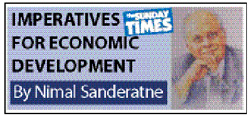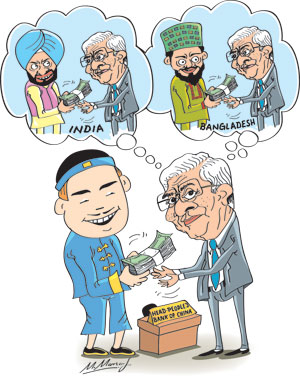Columns
Currency swaps to boost foreign reserves
View(s):The Government is confident that it could tide over the current foreign currency difficulties by obtaining currency swaps. Currency swaps are useful to reduce the looming external financial vulnerability and improve the balance of payments. They are a necessary palliative to tide over the current crisis. The government expects a favourable balance of payments outcome by the end of the year that would strengthen the reserves.
 Currency swap with China
Currency swap with China
The Central Bank of Sri Lanka (CBSL) will exchange currency with China up to ten billion Yuan (about US$ 1.5 billion) in an agreement “aimed at promoting trade and investment between the two countries.”
The Central Bank said that the currency swap allows it to borrow in any of the currencies involved. It is able to use these Yuan to repay obligations with China over a period of three years. This is of much relief due to the critical level of foreign reserves and large debt repayments this year.
Confidence
While most economists are of the view that Sri Lanka’s external finances are in a perilous state, the government has been very optimistic of strengthening the foreign reserves and improving the balance of payments this year.
This confidence is based on the expectation of obtaining foreign currency swaps from China, Bangladesh and India and on their expectation of a favourable balance of payments outcome this year. The foreign reserves are expected to increase to about US$ 5.5 billion at year’s end.
Currency swaps
A short term strategy of the Government is to bolster international confidence by arranging currency swaps. It is an immediate relief to the critical level of foreign reserves. It is no doubt a desperate move, but a necessary one.
China’s swap
The People’s Bank of China (China’s Central Bank) has provided Yuan equal to US$ 1.5 billion. Although it is in Yuan and could be used to only settle debts with China, since Sri Lanka’s debt repayment obligations and trade deficit with China this year is around that amount, it is a useful complement to the reserves.
 Indian swap
Indian swap
The request for a similar currency swap from India has not materialised yet. India’s requirement that Sri Lanka comes to an arrangement with the IMF may stall this, as the government is unwilling to adopt the principles of good economic governance, especially fiscal consolidation and economic reforms that are conditions for an IMF facility. However, geo-political factors may make India drop this condition and lay down other conditions of advantage to India.
Help from Bangladesh
The country has turned to Bangladesh too for a currency swap that may be forthcoming. Bangladesh has foreign reserves of US$ 70 billion compared to our less than US$ five billion.
Palliative not solution
These currency swaps will bolster the foreign reserves and improve foreign confidence in our external finances. However, they increase the country’s foreign debt and have to be repaid at the end of the agreed period. They are a useful palliative, not a panacea for the country’s weak external finances.
Trade balance
An improvement in the trade balance and the balance of payments is the only real means of reducing the external financial vulnerability. The Central Bank expects this year’s trade deficit to be moderate, as it was last year. Significant inflows of workers’ remittances. as in the pre-COVID years, as well as in 2020, and increased earnings from tourism and higher earnings from ICT services are expected to result in a balance of payments surplus. The pertinent issue is whether these expectations are realistic and likely to be realised.
Imports
The Achilles heel in the trade balance is the value of imports. As pointed out in previous columns, despite even enhanced import controls, import expenditure is likely to increase owing to higher prices of fuel, fertiliser, raw materials and food imports. There is the likelihood that food imports would increase, if there is a shortfall of rice and maize production. The international price of wheat grain is also expected to increase. For these reasons, import expenditure is expected to increase significantly. Imports are likely to exceed US$ 18 billion.
Exports
On the other hand, there is every prospect of increasing exports this year. Merchandise exports could be higher than the EDB projection of US$ 12 billion for this year, as several of the country’s pre-COVID industrial exports appear to be gaining ground, while the COVID induced manufactures of personal protective equipment (PPE) items are continuing to be demanded.
Furthermore, tea exports have increased in the first two months by two percent to US$ 213 million compared to US$ 207 million last year. Hopefully this trend would continue in spite of the current disruption of production on the high grown plantations. For these reasons, merchandise exports of US$ 15 billion is not unrealistic.
If these expectations are realised, the trade deficit could be contained to between US$ three to five billion. However, merchandise exports fell short of a million dollars a month in the first two months of this year.
Balance of payments
The government expects the balance of payments to be in surplus as they expect workers’ remittances to continue to rise as in 2020 to US$ 7.1 billion. There is considerable uncertainty in this as last year’s increase is difficult to explain as workers were returning to the country.
One explanation is that returning workers are remitting their accumulative savings through official channels rather than informal channels. If this is so, we could expect remittances to decline as the number of workers abroad are declining. On the other hand, it is suggested that expats in developed countries have increased their remittances to help their relations in financial difficulties. Either explanation leaves some doubt on the expectation of remittances to reach over US$ seven billion this year. It is hazardous to make an estimate of remittances, but a fall in remittances would cause a serious dent in the balance of payments.
Tourist earnings
The official expectation is that tourism will bring in about US$ 1.5 billion. This is realistic, if the global pandemic is contained and international travel revives. Conditions in both the countries of origin and ours would matter. Hopefully, by the later part of the year there would be an increase in tourists and this target would be achieved.
Other services
Income from ICT services are likely to improve somewhat. These could be a useful contribution to the BOP, if the target of around US$ two billion is achieved.
Concluding reflection
Much of the balance of payments outturn would depend on the speed and extent of the global recovery from the pandemic and the consequent global economic recovery. There is much uncertainty, but expectations that at the end of the year, the global economy would be resuscitated.
If all goes well, we may have a balance of payments surplus that would enhance the foreign reserves. Meanwhile currency swaps from India and Bangladesh would strengthen the international confidence in the country’s capacity to meet the large debt repayments.
The currency swaps are much needed palliatives that increase debt and are repayable. Only an improvement in the balance of payments could really strengthen the reserves.



Leave a Reply
Post Comment